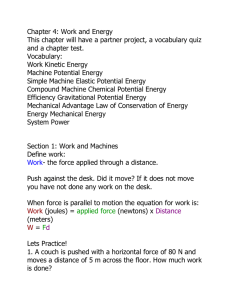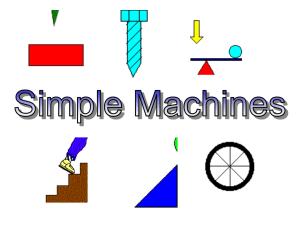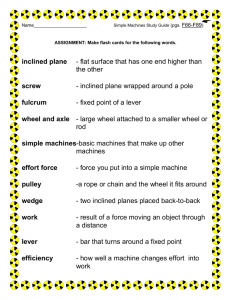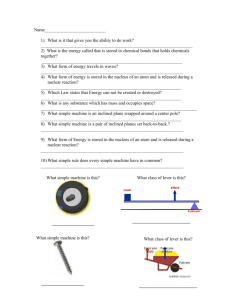8-4: Simple Machines
advertisement
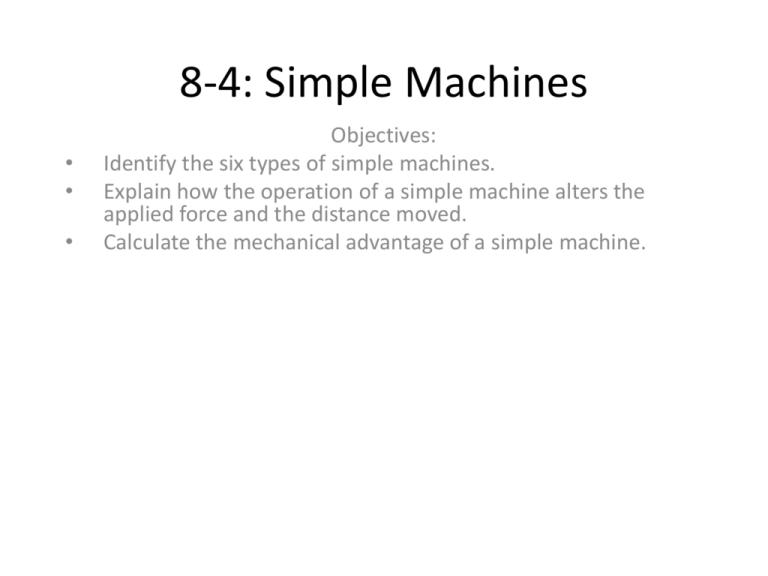
8-4: Simple Machines • • • Objectives: Identify the six types of simple machines. Explain how the operation of a simple machine alters the applied force and the distance moved. Calculate the mechanical advantage of a simple machine. A machine transfers energy from one place to another or transforms it from one form to another. • A machine is a device used to multiply forces or simply to change the direction of forces. • The concept that underlies every machine is the conservation of energy. A machine cannot put out more energy than is put into it. • Six Simple Machines • Lever • Inclined Plane • Wheel and Axle • Wedge • Pulley • Screw Wheel and Axel • Think of a shopping cart with no wheels! • By adding wheels to a cart we reduce the friction between the cart and the floor. Levers • A lever is a simple machine made of a bar that turns about a fixed point (Fulcrum). If the heat from friction is small enough to neglect, the work input will be equal to the work output. • W=Fd work input = work output • Since work equals force times distance, we can say: (force × distance)input = (force × distance)output Levers The pivot point, or fulcrum, of the lever can be relatively close to the load. • Then a small input force exerted through a large distance will produce a large output force over a short distance. • In this way, a lever can multiply forces. • However, no machine can multiply work or energy. In the lever, the work (force × distance) done at one end is equal to the work done on the load at the other end. The output force is eight times the input force. The output distance is one eighth of the input distance. The child pushes down 10 N and lifts an 80-N load. The ratio of output force to input force for a machine is called the mechanical advantage. The mechanical advantage is (80 N)/(10 N), or 8. Neglecting friction, the mechanical advantage can also be determined by the ratio of input distance to output distance. There are three common ways to set up a lever: • A type 1 lever has the fulcrum between the force and the load, or between input and output. • A type 2 lever has the load between the fulcrum and the input force. • A type 3 lever has the fulcrum at one end and the load at the other. Pulleys A pulley is basically a kind of lever that can be used to change the direction of a force. Properly used, a pulley or system of pulleys can multiply forces. • Pulleys are used in lifting heavy objects or machinery, elevators, cranes, etc… Pulleys a. A pulley can change the direction of a force. b. A pulley multiplies force. c. Two pulleys can change the direction and multiply force. Pulley This single pulley behaves like a type 1 lever. • The axis of the pulley acts as the fulcrum. • Both lever distances (the radius of the pulley) are equal so the pulley does not multiply force. • It changes the direction of the applied force. • The mechanical advantage equals 1. (Work in = Work out) Pulley This single pulley acts as a type 2 lever. • The fulcrum is at the left end of the “lever” where the supporting rope makes contact with the pulley. • The load is halfway between the fulcrum and the input. • 1 N of input will support a 2-N load, so the mechanical advantage is 2. • The load is now supported by two strands of rope, each supporting half the load. Pulleys The mechanical advantage for simple pulley systems is the same as the number of strands of rope that actually support the load. • The mechanical advantage of this simple system is 2. • Although three strands of rope are shown, only two strands actually support the load. • The upper pulley serves only to change the direction of the force. Pulleys • When the rope is pulled 5 m with a force of 100 N, a 500N load is lifted 1 m. • The mechanical advantage is (500 N)/(100 N), or 5. • Force is multiplied at the expense of distance. How does a machine use energy? • In any machine, some energy is transformed into atomic or molecular kinetic energy—making the machine warmer. Efficiency • The previous examples of machines were considered to be ideal because all the work input was transferred to work output. • In a real machine, when a simple lever rocks about its fulcrum, or a pulley turns about its axis, a small fraction of input energy is converted into thermal energy. Efficiency The efficiency of a machine is the ratio of useful energy output to total energy input—the percentage of the work input that is converted to work output. To convert efficiency to percent, you multiply by 100%. An ideal machine would have 100% efficiency. No real machine can be 100% efficient. Wasted energy is dissipated as heat. Efficiency • If we put in 100 J of work on a lever and get out 98 J of work, the lever is 98% efficient. We lose 2 J of work input as heat. • In a pulley system, a larger fraction of input energy is lost as heat. For example, if we do 100 J of work, the friction on the pulleys as they turn and rub on their axle can dissipate 40 J of heat energy. This pulley system has an efficiency of 60%. Inclined Planes • An inclined plane is a machine. • Sliding a load up an incline requires less force than lifting it vertically. Inclined Plane Pushing the block of ice 5 times farther up the incline than the vertical distance it’s lifted requires a force of only one fifth its weight. If friction is negligible, we need apply only one fifth of the force. The inclined plane shown has a theoretical mechanical advantage of 5. Inclined Plane • An icy plank used to slide a block of ice up to some height might have an efficiency of almost 100%. • When the load is a wooden crate sliding on a wooden plank, both the actual mechanical advantage and the efficiency will be considerably less. (Higher Coefficient of Friction) • Friction will require you to exert more force (a greater work input) without any increase in work output. Inclined Plane Efficiency can be expressed as the ratio of actual mechanical advantage to theoretical mechanical advantage. Efficiency will always be a fraction less than 1. Wedge • A wedge is essentially two inclined planes. • It reduces the force needed to move the distance. • Often used to split wood, or separate objects. • This is the most common simple machine. – Knife, saw blade, nail, etc… Screw • This auto jack shown is an inclined plane wrapped around a cylinder. • A single turn of the handle raises the load a relatively small distance. Screw • If the circular distance the handle is moved is 500 times greater than the distance between ridges, then the theoretical mechanical advantage of the jack is 500. • There is a great deal of friction in the jack, so the efficiency might be about 20%. • This means the jack actually multiplies force by about 100 times, so the actual mechanical advantage is about 100.




